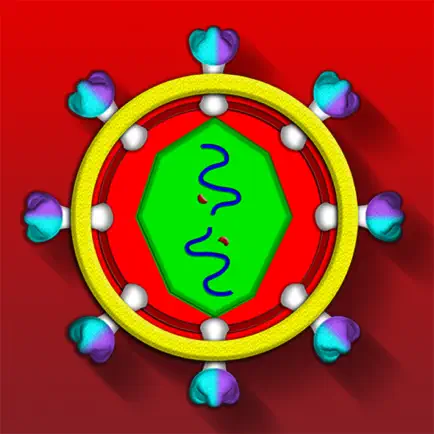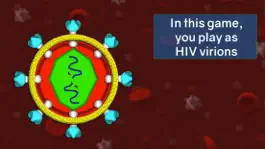
CD4 Hunter Hack 1.1 + Redeem Codes
Developer: Drexel University
Category: Education
Price: Free
Version: 1.1
ID: edu.drexel.ducom.hiv1
Screenshots



Description
Search. Attach. Invade. Multiply. Repeat. That’s your goal as an HIV virion, a CD4 Hunter™. How many target cells can you infect before you run out of time?
Stay tuned for more games about other microbes that threaten our health.
Follow us on Twitter: @Drexel_IMMID, #IMMID, #CD4Hunter
Visit our website: www.drexelmed.edu/immid
Game Features:
CD4 Hunter is a fast-paced, educational mini-game in which players take on the role of a human immunodeficiency virus type 1 (HIV-1) virion. By immersing real science within simple game play, users learn about the first step of HIV-1’s fascinating and complex replication cycle: binding and attachment. CD4 Hunter invites players to enter the bloodstream and grow their viral population by infecting specific target cells, while evading the immune system.
Download CD4 Hunter for free to:
• Learn complex science through fast-paced and addictive game play;
• Hunt for target cells in the human bloodstream;
• Control and grow your viral population; and
• Face antibody attacks as the immune system fights infection.
Learning Goals:
CD4 Hunter is the first in a series of mini-games to be developed by the Institute for Molecular Medicine and Infectious Disease at Drexel University College of Medicine, to introduce players to the dynamic world of infectious disease. CD4 Hunter was designed to supplement learning about the multi-stage process of the HIV-1 replication cycle, through interactive gameplay. This app is intended for use in biomedical science curriculum in higher education. Users apply knowledge about the biological processes involved during HIV-1 replication to advance in the game. CD4 Hunter focuses on meeting the following learning objectives:
1. Identify gp120 as a basic element of HIV-1 structure and apply knowledge about its function in the process of viral binding and entry.
2. Identify CD4+ T cells as targets for HIV-1 infection in humans and apply knowledge about their role in viral pathogenesis.
3. Identify and match the molecules on the surface of HIV-1 (i.e., gp120) and T cells (i.e., CD4+ receptor, and CCR5 and CXCR4 co-receptors) involved in viral binding and entry.
4. Apply concepts of viral tropism and immune evasion mechanisms to complete the HIV-1 infection cycle in CD4+ T cells.
Credits:
Executive Producer and Consultant
Brian Wigdahl, PhD
Chair, Department of Microbiology and Immunology (M&I); and Executive Director, Institute for Molecular Medicine and Infectious Disease (IMMID), Drexel University College of Medicine
Subject Matter Expert and Project Supervisor
Sandra Urdaneta-Hartmann, MD, PhD, MBA
Assistant Professor of M&I; and Director, the Center for Business and Program Development at IMMID, Drexel University College of Medicine
Game Designer
Carla Louise Brown, PhD
Postdoctoral Fellow, Department of M&I and IMMID, Drexel College of Medicine
Programmer and Artist
Vincent Mills
Co-op student at M&I and IMMID, Game Art and Production Program, Drexel University College of Media Arts and Design (Class of 2018)
Animator and Artist
Andrew Dean Bishop
Co-op student at M&I and IMMID, Animation and Visual Effects, Drexel University College of Media Arts and Design (Class of 2018)
SPECIAL THANKS TO:
Subject Matter Experts
Fred Krebs, PhD; William Dampier, PhD; Michael Nonnemacher, PhD; Vanessa Pirrone, PhD; Michael Wagner, PhD; and Mary Ann Comunale.
Beta Testers
Microbiology and Immunology Department graduate students
Drexel University Entrepreneurial Game Studio
*** Please help us improve this game by reporting any bugs to [email protected]. We welcome feedback and suggestions for upgrades and improvements. ***
©2017 Drexel University
Stay tuned for more games about other microbes that threaten our health.
Follow us on Twitter: @Drexel_IMMID, #IMMID, #CD4Hunter
Visit our website: www.drexelmed.edu/immid
Game Features:
CD4 Hunter is a fast-paced, educational mini-game in which players take on the role of a human immunodeficiency virus type 1 (HIV-1) virion. By immersing real science within simple game play, users learn about the first step of HIV-1’s fascinating and complex replication cycle: binding and attachment. CD4 Hunter invites players to enter the bloodstream and grow their viral population by infecting specific target cells, while evading the immune system.
Download CD4 Hunter for free to:
• Learn complex science through fast-paced and addictive game play;
• Hunt for target cells in the human bloodstream;
• Control and grow your viral population; and
• Face antibody attacks as the immune system fights infection.
Learning Goals:
CD4 Hunter is the first in a series of mini-games to be developed by the Institute for Molecular Medicine and Infectious Disease at Drexel University College of Medicine, to introduce players to the dynamic world of infectious disease. CD4 Hunter was designed to supplement learning about the multi-stage process of the HIV-1 replication cycle, through interactive gameplay. This app is intended for use in biomedical science curriculum in higher education. Users apply knowledge about the biological processes involved during HIV-1 replication to advance in the game. CD4 Hunter focuses on meeting the following learning objectives:
1. Identify gp120 as a basic element of HIV-1 structure and apply knowledge about its function in the process of viral binding and entry.
2. Identify CD4+ T cells as targets for HIV-1 infection in humans and apply knowledge about their role in viral pathogenesis.
3. Identify and match the molecules on the surface of HIV-1 (i.e., gp120) and T cells (i.e., CD4+ receptor, and CCR5 and CXCR4 co-receptors) involved in viral binding and entry.
4. Apply concepts of viral tropism and immune evasion mechanisms to complete the HIV-1 infection cycle in CD4+ T cells.
Credits:
Executive Producer and Consultant
Brian Wigdahl, PhD
Chair, Department of Microbiology and Immunology (M&I); and Executive Director, Institute for Molecular Medicine and Infectious Disease (IMMID), Drexel University College of Medicine
Subject Matter Expert and Project Supervisor
Sandra Urdaneta-Hartmann, MD, PhD, MBA
Assistant Professor of M&I; and Director, the Center for Business and Program Development at IMMID, Drexel University College of Medicine
Game Designer
Carla Louise Brown, PhD
Postdoctoral Fellow, Department of M&I and IMMID, Drexel College of Medicine
Programmer and Artist
Vincent Mills
Co-op student at M&I and IMMID, Game Art and Production Program, Drexel University College of Media Arts and Design (Class of 2018)
Animator and Artist
Andrew Dean Bishop
Co-op student at M&I and IMMID, Animation and Visual Effects, Drexel University College of Media Arts and Design (Class of 2018)
SPECIAL THANKS TO:
Subject Matter Experts
Fred Krebs, PhD; William Dampier, PhD; Michael Nonnemacher, PhD; Vanessa Pirrone, PhD; Michael Wagner, PhD; and Mary Ann Comunale.
Beta Testers
Microbiology and Immunology Department graduate students
Drexel University Entrepreneurial Game Studio
*** Please help us improve this game by reporting any bugs to [email protected]. We welcome feedback and suggestions for upgrades and improvements. ***
©2017 Drexel University
Version history
1.1
2017-09-08
This app has been updated by Apple to display the Apple Watch app icon.
Slowed down the speed of the tutorial.
Slowed down the speed of the tutorial.
1.0
2017-06-01
Ways to hack CD4 Hunter
- Redeem codes (Get the Redeem codes)
Download hacked APK
Download CD4 Hunter MOD APK
Request a Hack
Ratings
4.2 out of 5
17 Ratings
Reviews
eep19,
Suggestion
In the game, all cells infected with HIV die though in reality that is not always the case. Some cells become “virus producing factories” that keep producing more and more virions. To make the game more realistic and to add another element, once a player collected enough points maybe in a specified amount of time, the player could unlock one of these “factories”, making it easier to produce more virions. This could be another level.
gccpod,
Fun & informative—could be more detailed!
In the game, the extent of the replication process that is shown is pretty minimal— the HIV virus binds, enters the nucleus, and then morphs into more virions. This isn’t inaccurate, but is very simplified. It would be interesting to get a sense of how this replication occurs; namely, reverse transcriptase converts HIV RNA to DNA, and then enters the cell nucleus and combines with the cell’s DNA, etc. the game could show this process, or make the player convert RNA to DNA in some kind of matching game, as a “second level.”
Pduke3,
T-Cells Need to Produce more Virions!!!!!🔥🎉🏴
There are many problems with the model, but here is one improvement I think you should make to improve the accuracy of the game. The T-Cells should depict the production of more HIV, because the game makes it seem like HIV can be easily killed by the immune system, while in fact t-cell’s production of many virions is what makes HIV so deadly.
hajausbejjeeb,
Fusion
Well many components of HIV infection couldn’t properly be shown and still have the game remain usable, I do think it would be relatively easy for you to include the fusion step more explicitly. Instead of making it seem like the virion just pops right into the cell, it would be more accurate to show it slowly fusing into it.
limeblue2,
Informative and Fun Game
This game is a great interactive model to show how HIV works to infect T cells. The graphics are good and the tutorial is informational and understandable. To make this game more realistic, perhaps increasing the amount of cells available at a given moment would emphasize how the HIV virion just bumps into cells with a CD4 receptor and binds to them rather than specifically seeking them out.
kallen_2,
great game! add more levels!
I found this game very fun and informative, but would love to see potentially another level added about the specifics of transcription (how single stranded RNA is copied to produce double stranded DNA) and then how that becomes integrated into the host cell’s DNA. This could be a great way to learn about base pairing as well as how HIV DNA moves from the cytoplasm to the nucleus and integrates.
WAYNEISMYLIFE,
great interactive model!
i think adding a level or game mode between levels 1 + 2 to make the HIV life cycle more apparent would be both fun and informative. perhaps integration or reverse transcription. overall, this interactive model is helpful in understanding the larger concepts of how HIV infects the cell
fiselmi,
CCR5 evolution to CXCR4
I think a good improvement for this simulation could be to have some kind of progression in the co-receptor infection process. Right now, from level 1 it feels as though CCR5 and CXCR4 co-receptors are being infected at the same rate when, in reality, HIV evolves to recognize CXCR4 cells after originally infecting CCR5 co-receptors. Since this is an important step in the evolution of HIV to AIDS, I think it would be important to include in the simulation.
Ange12223,
Tang: Great game! Fun graphics
I would suggest adding a time clock below noting that in real life, the replication of HIV viruses operates on a different timeframe and different scale as the one played in the game. An added observation of HIV proliferation and how it operates in a real life from a dormant to active stage.
gswonk,
A Suggestion
To make the game more realistic, yet still playable, I would want the game designers to not only include T-cells, but also include other host cells that HIV can infect. Macrophages and dendritic cells, along with T-cells, can be infected by HIV.

